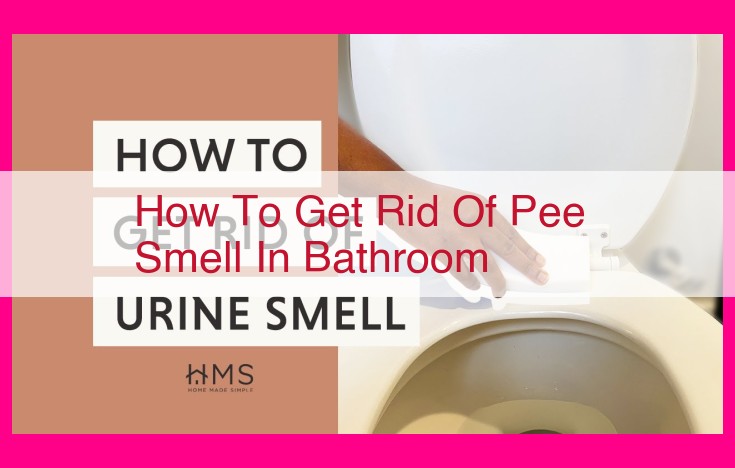Eliminate Bathroom Odors: Ultimate Guide To Identifying And Neutralizing Sources

To eliminate bathroom odors, identify and address sources like urine, ammonia, and uric acid. Use cleaning solutions like vinegar (for ammonia), baking soda (for uric acid), and water (for urine). Implement essential cleaning practices: clean toilets thoroughly, mop floors, and ventilate bathrooms. Take preventive measures by avoiding harsh chemicals, sealing porous surfaces, and flushing toilets regularly.
Battling Bathroom Odors: A Comprehensive Guide
Bathrooms, despite their essential function, often become havens for unpleasant scents. These odors not only hinder relaxation but can also pose health concerns. To effectively combat bathroom odors, it’s crucial to understand their root causes.
Unveiling the Sources of Bathroom Odor
The primary culprits behind bathroom odors are urine, ammonia, and uric acid.
- Urine: Consisting primarily of urea, when left untreated, urine breaks down into ammonia, producing a pungent, alkaline odor.
- Ammonia: This colorless gas is a byproduct of urine decomposition and has a sharp, acrid smell.
- Uric Acid: A component of urine, uric acid crystallizes and adheres to surfaces, releasing a persistent, musty odor.
Eliminating Bathroom Odors with Effective Cleaning Solutions
Bathrooms, while functional spaces in our homes, can often become havens for unpleasant odors. Luckily, understanding the sources of these odors and implementing targeted cleaning solutions can help us create a more refreshing bathroom environment.
Neutralizing Ammonia with Vinegar
Ammonia, produced by the decomposition of urine, is a primary contributor to bathroom odors. To combat this, embrace the power of vinegar. Its acidic nature effectively neutralizes ammonia, leaving your bathroom smelling cleaner and fresher. Simply fill a spray bottle with white vinegar and spray it around the toilet and other areas where ammonia lingers. Let it sit for a few minutes before wiping it away.
Dissolving Uric Acid with Baking Soda
Uric acid, another culprit behind bathroom odors, is often found in urine stains. To dissolve these stubborn deposits, turn to the trusty baking soda. Mix baking soda with a small amount of water to form a paste. Apply it to the stain, let it sit for several hours or overnight for tougher stains, and then scrub it away with a damp cloth. Baking soda’s alkaline properties will neutralize the uric acid, leaving your bathroom surfaces sparkling and odor-free.
Diluting Urine Spills with Water
Fresh or dried urine spills can release unpleasant odors. To address these, the key is prompt action. Blot up as much urine as possible, then rinse the spill with cold water. The water will dilute the urine and reduce its odor. Repeat this process several times until the urine smell is no longer noticeable.
Additional Tips for an Odor-Free Bathroom
Beyond utilizing these targeted cleaning solutions, there are other helpful practices to maintain a fresh and odorless bathroom:
- Clean Toilets Thoroughly: Regular toilet cleaning reduces the build-up of urine and stains.
- Mop Floors and Scrub Surfaces: Cleaning floors and scrubbing surfaces removes dirt and grime that can trap odors.
- Ventilate Bathrooms: Proper ventilation allows air circulation, reducing moisture and odor accumulation.
- Flush Toilets Regularly: Flushing toilets prevents lingering odors from urine waste.
Essential Bathroom Cleaning Practices
- Emphasize regular cleaning practices to prevent odor buildup:
- Cleaning toilets thoroughly to remove urine and stains
- Mopping floors and scrubbing surfaces to eliminate dirt and grime
- Ventilating bathrooms to reduce moisture and promote air circulation
## Essential Bathroom Cleaning Practices for Odor Control
Maintaining a clean bathroom is not only aesthetically pleasing but also crucial for preventing unpleasant odors. Regular cleaning practices are essential to eliminate odor sources and ensure a fresh and hygienic environment. This guide will delve into the essential cleaning practices that effectively combat bathroom odors.
Cleaning Toilets Thoroughly
The toilet is a primary source of bathroom odor, as it harbors urine and fecal matter. To prevent lingering odors, clean the toilet regularly, focusing on stains and areas where urine may splash. Use a disinfecting toilet bowl cleaner to kill bacteria and deodorize the bowl. Scrub the exterior and seat with a mild cleanser to remove dirt and grime.
Mopping Floors and Scrubbing Surfaces
Floors and surfaces can accumulate dirt, hair, and other debris that contribute to bathroom odors. Mopping floors with a disinfectant cleaner removes these contaminants, preventing odor buildup. Scrubbing surfaces, such as counters, sinks, and faucets, with a multi-surface cleaner eliminates residue and leaves them sparkling clean.
Ventilating Bathrooms
Proper ventilation is essential for reducing moisture and promoting air circulation. Bathrooms tend to be humid due to showers and baths, which can create a breeding ground for bacteria and mold. Open windows or use an exhaust fan to ventilate the bathroom and remove moisture. This will help prevent musty odors and promote a fresh environment.
Preventive Measures for Odor Control: Keeping Your Bathroom Fresh
Avoid Harsh Chemicals That Damage Surfaces
Harsh chemicals may seem like a quick solution for cleaning, but they can actually do more harm than good. They can damage bathroom surfaces, such as tile, grout, and fixtures, creating microscopic scratches that trap odors. Instead, opt for gentle cleaning products that are designed for bathroom use.
Seal Porous Surfaces to Prevent Odor Absorption
Porous surfaces, such as natural stone, grout, and wood, can absorb odors like sponges. To prevent this, seal these surfaces regularly with a water-resistant sealant. This will create a barrier that keeps odors from seeping in and lingering.
Flush Toilets Regularly to Prevent Lingering Odors
One of the most important steps in preventing bathroom odors is to flush toilets regularly. Even a few hours of sitting stagnant can cause urine and waste to break down and release unpleasant scents. Flushing the toilet empties the bowl and removes the source of the odor.